New
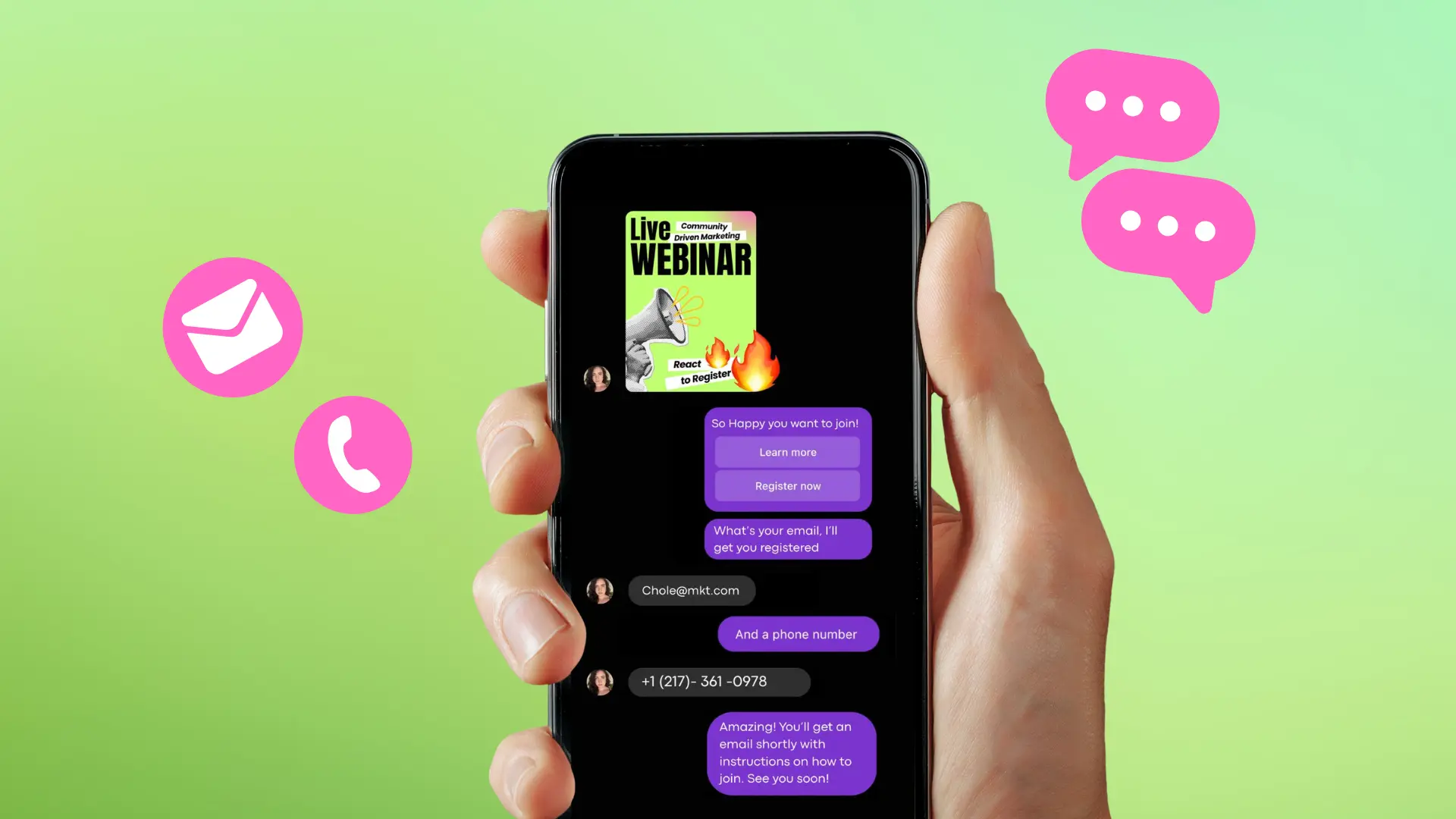
Turn Your DMs Into Lead Gen!
Learn how to collect lead data from your DMs such as email addresses, phone numbers, and more right from your social inbox. If you are not yet automating your DMs your competitors are outpacing you.

How Something Social Saved 75% of Their Time and Increased Revenue by 15%
See how a fast-growing agency improved operations, cut down hours of manual work, and unlocked new revenue opportunities with Vista Social.
New

50 Unique Social Media Ideas for Consistent Content Creation
Discover 50 unique social media post ideas to engage your audience, grow your brand, and maintain a consistent content strategy with ease!
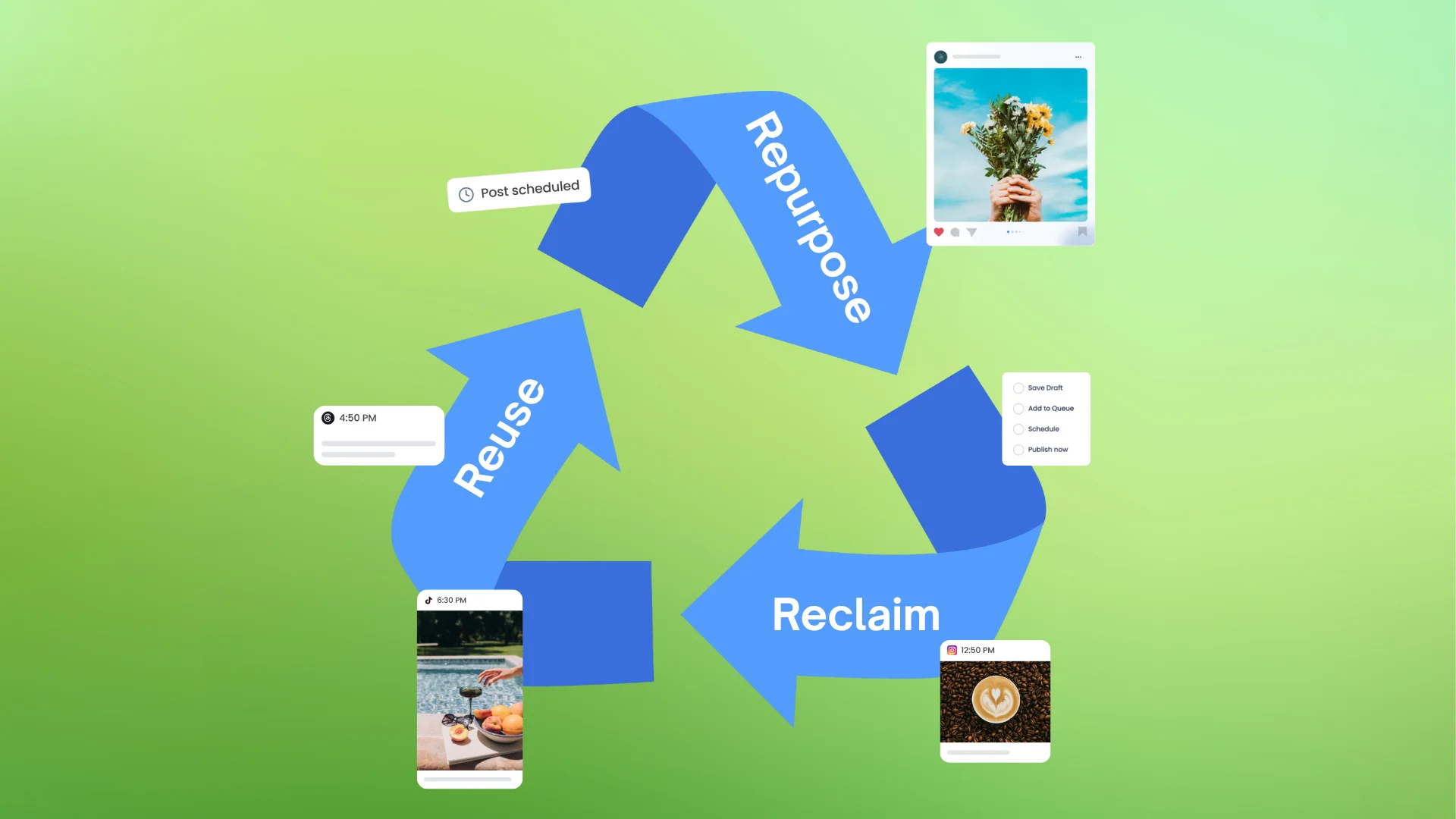
Mastering Content Reuse: The Key to a Consistent and Sustainable Posting Strategy
Published on March 30, 2025
12 min to read
10 Social Media Sentiment Analysis Strategies for 2025
Summarize with AI
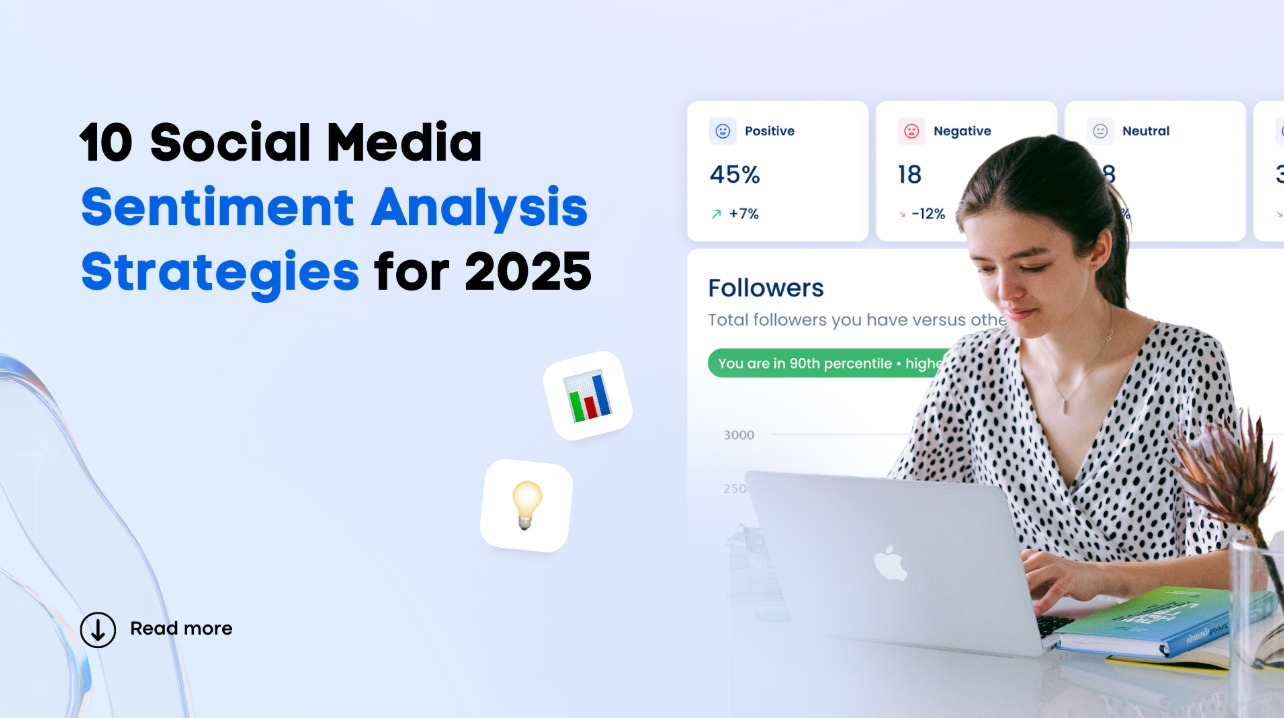

Table of Content

Most people get social media sentiment analysis strategies wrong—and it shows.
Sure, sentiment analysis gives you a glimpse into how people really feel. But it’s what you do with that insight that separates the good from the great.
So, how do you actually make it work for you?
This blog is your cheat code.
Inside, you’ll uncover ten bold strategies to help you spot trends faster, respond smarter, and turn social buzz into real results.
Ready to read the room like a pro and keep your brand—or your clients—ahead of the curve?
Let’s dive in.
Table of contents
What you will learn
- What are social media sentiment analysis strategies?
- Why do you need social media sentiment analysis strategies?
- Top 10 social media sentiment analysis best practices
- Leverage Vista Social for seamless social media sentiment analysis
- Pitfalls to avoid when implementing social media sentiment analysis strategies
- FAQs on social media sentiment analysis strategies
- Ready to implement smarter social media sentiment strategies?
What are social media sentiment analysis strategies?
Social media sentiment analysis strategies are systematic approaches to turning raw data into meaningful action, helping brands stay ahead.
It’s not just about identifying whether the buzz around your clients’ brands is positive, negative, or neutral.
It’s also about uncovering the “why” behind those emotions and how to respond effectively.
Bottom line?
With the right sentiment analysis strategies, you’re not just listening to your clients’ audiences; you’re speaking their language and building a stronger connection that drives results.
Must read: Social Media Sentiment Analysis: A Comprehensive Guide
Why do you need social media sentiment analysis strategies?
Developing the right customer sentiment analysis strategies is crucial for the following.
Decoding audience emotions
Understanding how your clients’ audiences feel about their brands isn’t just insightful—it’s powerful.
Sentiment analysis helps you go beyond surface metrics such as likes and clicks to uncover the emotional pulse of your clients’ social media communities.
Are people genuinely excited about your clients’ new campaign, or do their comments have an edge of sarcasm that’s flying under the radar?
Knowing the difference means you can react appropriately and fine-tune your messaging to resonate more deeply.
Spotting trends early
Imagine spotting a negative brand sentiment shift before it becomes tomorrow’s viral disaster—or jumping on an emerging positive trend to amplify the buzz.
Sentiment analysis equips you to act quickly.
With trends evolving faster than you can say “sentiment,” catching these shifts early could mean the difference between leading the conversation or scrambling to clean up the fallout.
Preventing PR crises
We’ve all seen it happen—a single post snowballs into a full-blown PR nightmare.
Sentiment analysis serves as your early warning system, flagging negative public sentiment so you can address it before it spirals out of control.
Whether the issue is a misunderstanding or a genuine one, timely responses show your clients’ audiences that they’re listening, which can keep their brand reputation intact.
Strengthening brand loyalty
People love brands that get them.
When your clients respond to positive sentiment, whether a heartfelt thank-you or a playful comment, it creates a connection.
Sentiment analysis helps you identify these opportunities to engage and make your clients’ audiences feel valued.
And loyal audiences?
They can be your clients’ biggest cheerleaders, sharing their content and advocating for their brands without being asked.
Making data-driven decisions
Analyzing emotional trends lets you see what’s working and what isn’t and how to adjust your sentiment analysis strategy.
Is your client launching a new product?
Gauge excitement in real time.
Is another client rolling out a campaign?
A solid sentiment analysis strategy helps you find out what elements hit the mark and optimize as you go.
Enhancing customer service
Audiences generally want to know that your clients hear AND listen to them.
Sentiment analysis helps you spot recurring concerns, questions, or frustrations early so that customer service teams can address them proactively.
Happy customers mean better reviews, stronger relationships, and fewer social media flare-ups that can negatively affect your clients’ brands.
Staying competitive
Sentiment analysis can give your efforts an edge by helping you better understand your clients’ audiences than their competitors.
While others focus on generic engagement metrics, you can develop a social strategy and content based on how your clients’ followers truly feel, allowing you to stay ahead.
Tailoring your tone
No one likes tone-deaf content.
Whether your clients’ audiences are hyped or concerned, sentiment analysis can help you adjust the tone of your content and interactions to fit the mood.
Playful? Serious? Empathetic? The right sentiment analysis strategies can help you get it right every time, leading to skyrocketing engagement.
Boosting engagement
Social media audiences who feel seen and understood will likely engage more with your clients’ content and brands.
Positive sentiment analysis can highlight engagement opportunities to amplify good vibes, share gratitude, or celebrate wins with your clients’ followers.
That emotional connection keeps them coming back for more, fostering continuous engagement and, in turn, conversions.
Building a stronger strategy
Understanding the sentiment of your clients’ audiences can help you create social media campaigns and strategies that hit the emotional sweet spot.
Whether humor, empathy, or inspiration, these sentiment analysis insights equip you to develop more impactful, resonant content that drives engagement, clicks, and conversions.
Top 10 social media sentiment analysis best practices
Implement your social media sentiment analysis efforts like a boss with the tried and tested tips below.
Must read: Social Media Sentiment Analysis vs Social Media Tracking
1. Set clear objectives
Having clear goals is like giving your sentiment analysis a GPS—it ensures every insight leads you in the right direction.
Instead of just social media monitoring for sentiment, think bigger: Do you want to help clients build brand loyalty, measure campaign success, or uncover customer pain points?
Identifying your goals helps shape and inform your sentiment analysis strategies, ensuring alignment across your efforts.
Actionable tips:
- Break your goals into short-term and long-term. For example, short-term could be tracking sentiment around your client’s product launch, while long-term could be measuring overall brand health over six months or a year
- Create a goal hierarchy. For instance, start with “improve customer satisfaction” and break it into smaller objectives such as “respond to negative feedback within 24 hours”
- Review your goals regularly and refine them to match your clients’ evolving business priorities
2. Use advanced sentiment tools
Basic tools won’t cut it in 2025, especially with the complexity of modern online conversations.
After all, sarcasm, slang, and emojis aren’t easy to decode.
Advanced Artificial Intelligence (AI) tools go beyond traditional keyword tracking to analyze tone, context, and cultural nuances.
Actionable tips:
- Invest in tools with advanced features and deep learning capabilities that can understand customer sentiment shifts within specific industries
- Run pilot tests with various tools and compare the sentiment scores’ accuracy with real-world reactions from your clients’ audiences
- Train your team to interpret sentiment data beyond automated reports to avoid misreading insights
3. Monitor key platforms
If your clients’ target audiences spend hours scrolling TikTok, tracking sentiment on LinkedIn won’t give you meaningful insights.
Meet your clients’ audiences where they are by focusing on the right platforms.
Actionable tips:
- Analyze your clients’ past campaign performance on various social media platforms to identify where engagement peaks (and dips)
- Build platform-specific strategies. For TikTok, track sentiment for trending sounds and hashtags; for LinkedIn, focus on sentiment around industry-related discussions
- Don’t neglect emerging platforms such as Bluesky. Help your clients stay ahead of the curve by monitoring sentiment trends early across social networks
4. Track positive and negative sentiment
Positive sentiment celebrates your clients’ wins, but negative sentiment reveals where they need to improve.
So don’t skip the “bad stuff” since this can leave gaps in your strategy and risk turning small issues into big ones.
Actionable tips:
- Set up sentiment alerts to flag spikes in negative comments immediately so your team can jump into action promptly and keep issues from escalating
- Build a “sentiment crisis toolkit” with pre-approved responses for common complaints. Doing so can save you time and ensure consistency in your clients’ content and interactions during negative sentiment flare-ups
- For positive sentiment, identify recurring themes, such as great customer service comments or specific product feature highlights from audiences that you can amplify in your clients’ future campaigns
5. Incorporate social listening
Sentiment analysis is powerful but can miss the full story without context.
Social listening bridges that gap by revealing the “why” behind sentiment trends.
Is your client’s audience reacting to a new competitor or a cultural moment?
Social listening helps you connect the dots to get the full picture, which you can leverage to improve your content and strategies.
Actionable tips:
- Track trending keywords or hashtags related to your client’s brand or industry daily. For example, if your client is in the fashion industry, monitor terms such as “sustainable clothing” or “fast fashion backlash”
- Use social listening tools to filter data by sentiment, allowing you to focus on relevant conversations about your clients and extract the right insights instead of drowning in data
- Pair sentiment analysis insights with social listening reports during weekly strategy meetings with your team to refine your clients’ campaigns faster
6. Segment your audience
Your clients’ audiences are not a unified group—they’re often a mosaic of different demographics, interests, and values.
Segmenting sentiment data helps you tailor strategies that resonate with specific subsets of your audience.
It helps you tailor content more specifically to each segment’s needs, increasing their chances of engaging with your clients’ posts.
Actionable tips:
- Use sentiment analysis tools with segmenting features to group your clients’ audience data by demographics, such as age, location, or behavior patterns
- Create campaigns based on sentiment data for each segment. For instance, if Gen Z audiences love your client’s bold, humorous content but millennials prefer informative, thoughtful posts, adapt the tone of your posts for each group
- Regularly update segmentation criteria to reflect changes in audience preferences or social trends. Doing so ensures you’re still targeting the right audience groups and tailoring content accordingly
7. Monitor competitors
Sentiment analysis isn’t just about understanding the sentiment toward your clients.
Monitoring competitors helps you learn from their wins, dodge their missteps, and even spot opportunities they’re missing.
Try Vista Social for Free
A social media management platform that actually helps you grow with easy-to-use content planning, scheduling, engagement and analytics tools.
Get Started NowActionable tips:
- Track sentiment trends around competitor campaigns. If the competitor’s eco-friendly initiative is getting praised, consider highlighting your clients’ sustainability efforts
- Monitor negative sentiment about competitors to identify gaps in their customer experience, then position your clients as the solution
- To benchmark your clients’ reputations, compare monthly sentiment scores between their brands and competitors. It can give you a good idea of how your clients fare compared to competing brands on social media
8. Keep an eye on trends
Trends can make or break sentiment.
Imagine your client’s brand aligning with a viral movement—that’s gold.
Or worse, you unknowingly post something tone-deaf during a sensitive time.
Staying on top of trends ensures that your client’s messaging is relevant and empathetic, which can boost engagement.
Actionable tips:
- Use tools that track trending hashtags and topics in your clients’ industries, such as BuzzSumo or Google Trends
- Identify emotional triggers behind trends. If your client’s audience rallies around sustainability, integrate eco-conscious messaging into their campaigns to draw out a similar response from followers
- Assign team members to “trend watch” daily, ensuring you’re always in the loop.
9. Respond to Feedback Proactively
Positive or negative feedback is your audience’s way of telling you what’s working and what needs fixing.
Sentiment analysis helps you act on this feedback faster and more effectively.
Actionable tips:
- Develop a response framework for different sentiment levels. For example, thank positive reviewers publicly, address concerns privately, and escalate major issues internally
- Use sentiment analysis to prioritize responses. Flag urgent concerns for immediate attention and automate replies for neutral or less time-sensitive feedback. This way, your team (or your client’s team) can manage and address issues promptly
- Celebrate positive brand sentiment. Share glowing testimonials in your clients’ content or create posts acknowledging customer love. It’s a great way to show appreciation for customers and maintain a positive brand image, fostering deeper and lasting relationships
10. Continuously refine your strategy
The digital landscape changes fast, and so do audience expectations.
Sentiment analysis strategies that worked last year may not hold up today, so refine your approach continuously to keep your insights relevant and actionable.
Actionable tips:
- Schedule quarterly reviews to evaluate sentiment trends and adapt your clients’ social media content and engagement strategies based on insights
- Experiment with new tools or data visualization methods to make your sentiment analysis insights clearer and easier to act on. It can also make your data insights easier to view and digest
- Conduct A/B testing on campaigns to see how tone, messaging, or timing changes affect your clients’ audience sentiment and engagement
Leverage Vista Social for seamless social media sentiment analysis
Implement your sentiment analysis strategies effortlessly with Vista Social.
The all-in-one social media management platform offers robust sentiment analysis tools and other features, from social listening and scheduling to reporting and analytics.
Must read: 20+ Sentiment Analysis Tools for Agencies & Brands for 2025
The platform’s sentiment analysis feature lets you track and assess the tone, emotion, and sentiment behind user interactions from your clients’ connected social media profiles.
Vista Social’s sentiment analysis applies across the platform’s Listeners, Inbox, and Reports features.
Every conversation pulled from your client’s profile to the Social Inbox is automatically tagged with a sentiment icon that indicates negative, positive, neutral, or mixed sentiment.
The tags include brief explanations for each sentiment classification.

With the Social Listening feature, you can filter the conversations pulled by the Listeners you set by sentiment.
Listeners track and pull conversations based on the keywords or phrases you specify.
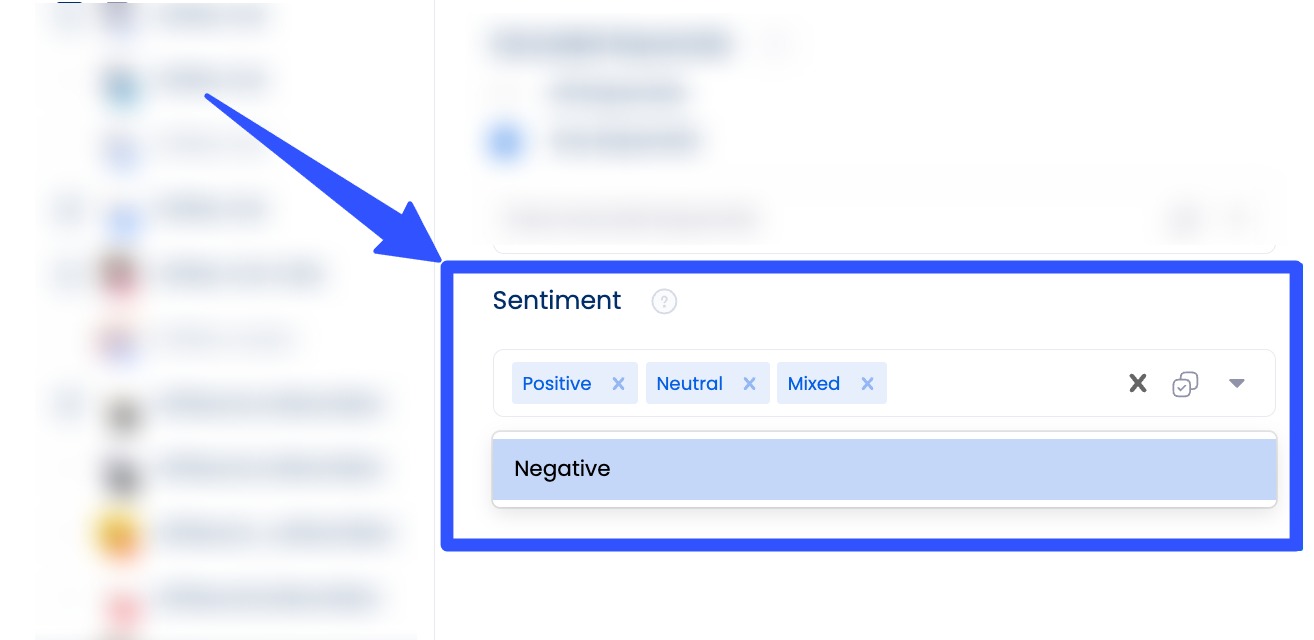
Vista Social offers a dedicated sentiment analysis report to analyze sentiment data (emotions across direct messages, mentions, comments, and reviews).
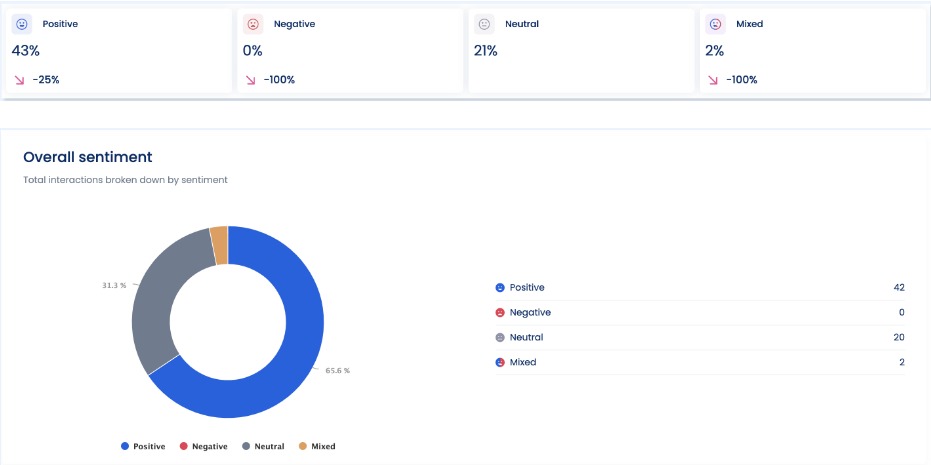
The sentiment analysis report’s dashboard tracks metrics, including the following:
Must read: Social Media Sentiment Analysis Dashboard: Tips & FAQs
- Overall sentiment
- Daily sentiment based on daily interactions by expressed sentiment
- Total sentiments by type
- Sentiment trends, categorized by the Top positive sentiment and Top negative sentiment

The platform lets you schedule all your reports, including social media, performance, and sentiment analysis reports, to generate and share with your team and clients automatically via exported CSV or PDF files and intuitive links.
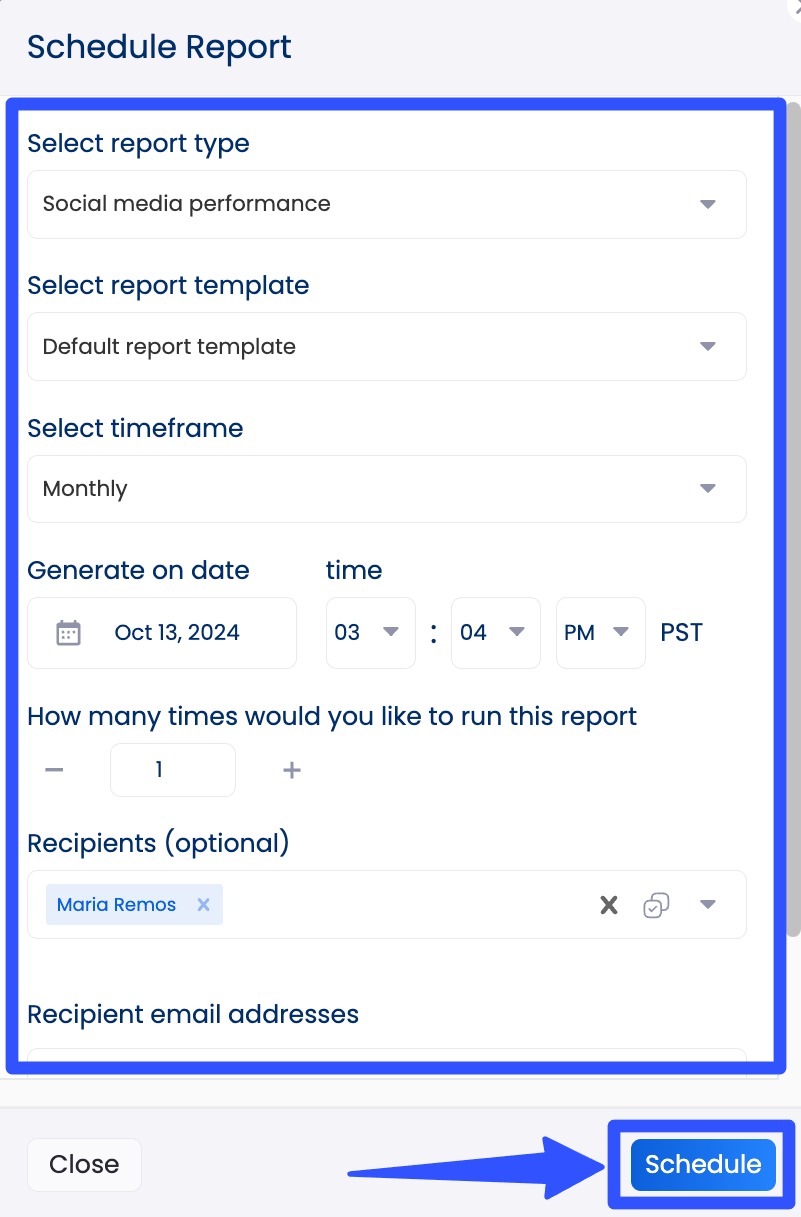
You can also create custom analytics report templates in the Report Builder to show the metrics and insights that matter most to your team and clients.
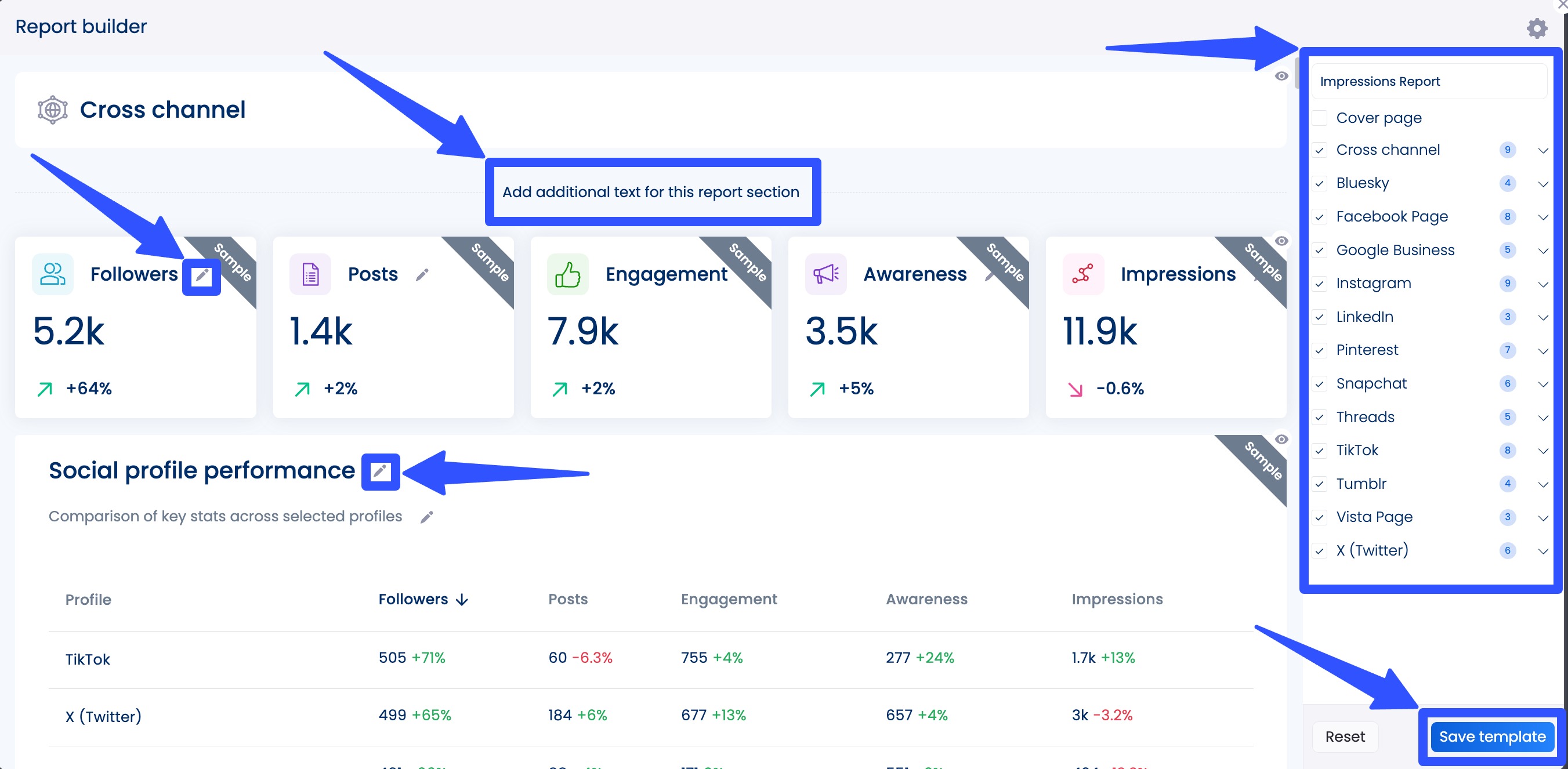
Vista Social offers more robust social media management features, including the following.
- Social media publishing and scheduling, including smart and bulk publishing
- Engagement and community management featuring a Social Inbox
- Social listening
- Review management
- Content calendar
- Multi- or single-stage post approval workflows
- Media library
- Hashtag tools
- Link in bio tool
- Employee advocacy
- Etc.
Pitfalls to avoid when implementing social media sentiment analysis strategies
Avoid the common mistakes below when deploying your sentiment analysis strategies.
Failing to consider sarcasm
Ah, sarcasm—social media’s guilty pleasure.
It’s what makes social posts so entertaining yet so tricky to interpret.
Suppose someone starts a Threads post that says, “Wow, this feature update is just what I needed (insert eye-roll emoji).”
Your sentiment tool might tag this as positive because of “wow” and “needed.”
But nope, that’s a sarcastic roast.
Combatting sarcasm requires more sophisticated Natural Language Processing (NLP) and machine learning tools.
Some tools analyze sentence structure, tone, and conversations to detect sarcasm.
For these nuanced cases, consider supplementing your analysis with human oversight to get the emotions behind the sarcastic comments right.
Not including context
Social media isn’t a vacuum, and context is everything.
Words like “lit” or “killer” can swing wildly based on who’s speaking and what they’re talking about.
If someone says, “This campaign is killer,” that could mean they love it.
But paired with “our traffic is tanking,” it’s a crisis.
Advanced sentiment tools use context clues to determine what people mean by analyzing multiple layers of conversation, hashtags, images, and replies.
Without context, your analysis may feel like decoding hieroglyphs blindfolded.
Underestimating emojis
Don’t underestimate emojis—they pack a ton of emotional punch.
Take the 🤣 emoji: It’s not just the tears, it’s like “I’m laughing so hard, I’m crying.”
Ignoring these symbols is like watching a movie on mute.
Sentiment analysis tools allow you to “read” emojis to decode audience sentiment more accurately.
The key is regularly updating your emoji data to reflect the evolving meanings in online culture (because emoji slang is a thing).
Not keeping up with trends
Internet language changes faster than a trending hashtag.
That meme or catchphrase that’s all over social today? It’s probably dead tomorrow.
For instance, words like “yeet” and “stan” may not have existed in your sentiment tool’s last update.
Stay ahead by regularly retraining your sentiment analytics tools using fresh data from current social platforms.
Also, assign someone to monitor pop culture buzz so nothing slips through the cracks, keeping your sentiment analysis strategies relevant.
Oversimplifying emotions
Social media users are generally layered.
For example, someone may feel frustrated and relieved after resolving an issue.
If your tool only registers “neutral” or “negative,” you can miss the nuances.
To understand your clients’ audiences’ sentiments, find software that detects emotions such as anger, joy, fear, or even “meh” vibes.
Not factoring in bias
Bias in your data is the invisible hand that can steer your sentiment analysis off course.
Your analysis won’t reflect reality if your training data disproportionately represents certain opinions or demographics.
Imagine a car review tool trained only on positive car reviews—it’ll skew everything as positive.
To overcome this, diversify your data sources and run periodic audits to identify and mitigate bias, ensuring you get accurate data and insights.
Ignoring privacy rules
Sentiment analysis often involves scraping publicly available data.
However, just because data is public doesn’t mean privacy regulations don’t apply.
Failing to adhere to GDPR, CCPA, or other privacy laws can land you and your clients in hot water.
Avoid analyzing sensitive, personally identifiable information (PII), and always notify users if you’re leveraging public data. Integrating a web scraper API with ethical scraping practices ensures data is collected responsibly. Transparency earns trust and keeps everything above board.
FAQs on social media sentiment analysis strategies
What are the common challenges of sentiment analysis?
The common challenges of social media sentiment analysis include the following.
- Misinterpreting irony or sarcasm
- Handling slang and multilingual data
- Addressing training data biases
- Keeping up with evolving language trends
How can sentiment analysis improve customer experience?
Sentiment analysis can identify customer pain points and areas of satisfaction, allowing you to tailor responses, improve products or services, and foster stronger relationships with audiences.
How often should you conduct sentiment analysis?
It depends on your clients’ business goals.
Real-time or weekly analysis may be best for crisis management or campaign tracking.
For broader trends, monthly or quarterly reviews can be enough.
Ready to implement smarter social media sentiment strategies?
Embrace innovative strategies to supercharge your social media sentiment analysis.
Use the best tool for effective and efficient social sentiment analysis, ensuring you get the right insights to shape and inform your marketing efforts. Create your Vista Social account now.
About the Author
Content Writer
Jimmy Rodela is a social media and content marketing consultant with over 9 years of experience, with work appearing on sites such as Business.com, Yahoo, SEMRush, and SearchEnginePeople. He specializes in social media, content marketing, SaaS, small business strategy, marketing automation, and content development.
Read with AI
Save time reading this article using your favorite AI tool
Summarize with AI
Never Miss a Trend
Our newsletter is packed with the hottest posts and latest news in social media.
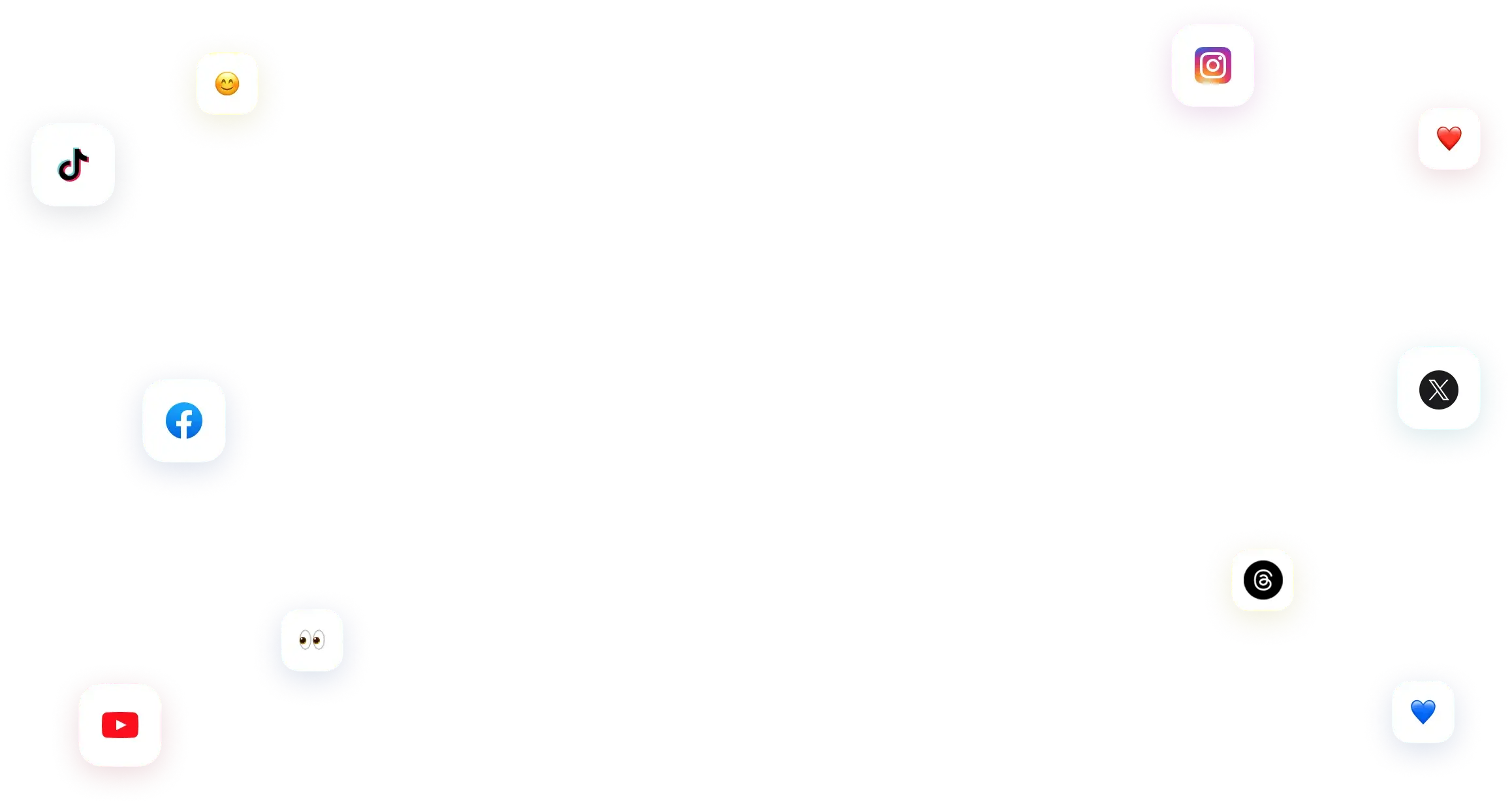
You have many things to do.
Let us help you with social media.
Use our free plan to build momentum for your social media presence.
Or skip ahead and try our paid plan to scale your social media efforts.
P.S. It will be a piece of cake 🍰 with Vista Social
Subscribe to our Newsletter!
To stay updated on the latest and greatest Social Media news. We promise not to spam you!


